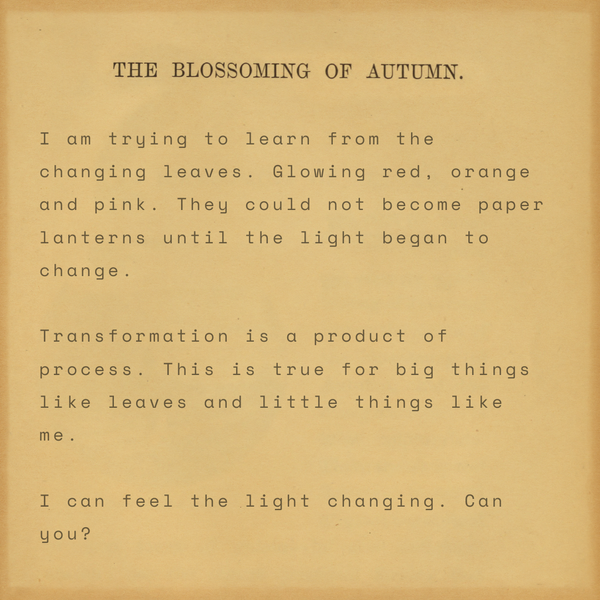Breakfast can take you quite far
I grew up in a mixed reality.

I grew up in a mixed reality an environment where elements of virtual worlds and the real world are combined. My virtual world was formed by my religion, The Church of Jesus Christ of Latter-day Saints. After a failed 19th-century attempt to maintain a theocracy with physical borders, my Church continued to build its state in a spiritual simulation distributed across members hearts and minds. Purpose-built for the eternal progression of mankind, this virtual reality was a spatial narrative framed by the borders of the myth of the separate spheres.
This narrative mapped neatly onto my real world, a reality shaped by the 1990s economic boom and suburban cul-de-sacs. This should have made it apparent that my virtual world and what I’d considered the real world were both heaven-building simulations built on top of the same engine: American Industrial capitalism, a framework that is astonishingly good at platform extraction. Instead, the reinforcement made both my virtual world and my real world feel inevitable.
At church, I learned that the separate spheres were modeled on an eternal constraint equation. The mid-century white middle-class American Dream, with its single-family income and stay-at-home mother, was a kind of prototype of heaven. The tension between man’s authority and woman’s care kept heaven whole.
Male-dominated market authority was a shade of Mormonism’s male-only priesthood authority. Both forms of authority expressed themselves through property rights, the authority to decide how a resource is used. Salvation was a limited resource. Heaven had to be enclosed so that it would not be exhausted.
As a kid, I imagined eternity in a celestial suburb, tracts of heavenly homes surrounded by on-ramps to creation. The women stayed home to sweep the stars while men commuted to work to “build worlds without number.” I didn’t like this vision. But God wasn’t going to alter existence because I didn’t like my role in His work and His Glory.
As a girl, I was taught I could help people desire heaven by influencing them with my goodness. It was a woman’s job to create and maintain the church community while men administered. Men presided over women, but women were supposed to inspire men to preside well. When a man lived up to a woman’s goodness, he became worthy of heaven. I was taught to be an influencer before the word even existed.
The Edenic Appeal of Ballerina Farm
"It’s no wonder that many LDS women have taken to Momfluencing and Homefluencing (and now Farmfluencing) like fish who finally found water."
Ineligible for the priesthood, women had no right to heaven. This was solved with a kind of celestial coverture; women could get into heaven if they were bound to a man with the priesthood. My salvation could be secured through sealing, the process of making a covenant that binds a man and woman to one another, their children and heaven.
I made this covenant when I married my husband in a Southern California LDS temple. It has a name, The New and Everlasting Covenant. I didn’t know more than its name when I knelt beside an altar and promised myself to it. I know more now. This covenant eternalizes heterosexuality, the authority of men, and the subjugation of women.
It promises men that they can become like gods, making worlds without end. To qualify for this highest form of exaltation, they would practice polygamy in the eternities. One man bound to many women. The covenant threatens women with destruction if they do not “abide this commandment.” I was 21 years old when I gave up my will to keep myself, and the children I would have, within the network of heaven.
The LDS Church has an online dashboard where we can see our family trees and data structures that show us where sealings linked one person to another, generation after generation. They look like Merkle trees, the first sealing in our line was the root of our salvation.
Every sealing afterward reinforced the truth of the root and the root reinforced the truth of every sealing. The physical world would be translated into an eternal home when we’d invited everyone, living and dead, to join our network of salvation.
Unable to discern proof from truth, I often fell asleep tracing the edges and nodes of this future final structure, marveling at its simplicity. It took me a long time to question the root of that tree. It took me longer to understand this kind of cryptographic commitment scheme makes it impossible to change the root of the tree without invalidating the entire structure.
The Mormon virtual had a founder and a leader, we called him Prophet. We were assured our network of salvation was decentralized and ruled by common consent. We voted at worldwide meetings by raising our right hands. But neither power nor protocols are neutral. Our behavior was compelled by incentive mechanisms built into the system - rewards, penalties, privileges and tokens.
From Altar Bound, a series on abuse on the LDS Church:
I’ve had people ask me how LDS people can remain in the church as it becomes clear abuse is systemic. Whenever I hear that question, I just want to ask the person - When was the last time you believed something that shaped your entire reality? Have you ever tried to exist outside of gravity?
Criticizing the church, especially if you still hold the shape of its heaven, is not just difficult for LDS people to do. It does not just lead to shunning from community members. It is a choice risks eternity. They tell us we can only keep our children forever if we are willing to sacrifice them right now.
We were rewarded for proof of worthiness with “tokens” that, according to LDS Prophet Brigham Young, “enable you to alk back to the presence of the Father, passing the angels who stand as sentinels, being able to give them the key words, signs and tokens…”The incentives existed in a mixed reality too. Just one example? Members who did not pay a full tithe which the church defines as a “full ten percent of your income,” lost access to the LDS temple and its tokens.
Tithing funded the spaces where the virtual world blended with my real world. It paid for alternate systems of education and welfare and the buildings where we worshipped. In those spaces, the network of salvation took on a physicality that made it impossible to abstract. The rewards became more real, and the penalties did too. Whenever our prophet announced another temple was being built somewhere in the world, I cried with joy. I was witnessing the real-time rendering of heaven.
I learned later that the LDS Church wasn’t really using real estate to house the work of heaven. Instead, it seems they think heaven is built with real estate. The Church is now the second-largest private landowner in the United States. It has plans for some of that portfolio. There are 133,000 acres in Florida the Church would like to develop into a city with a population of 500,000. According to watchdog The Widow’s Mite Report, it’s a “long-term plan, with a 50 - 60 year time horizon.” What is a generation when you have eternity?
In February 2023, the SEC fined the LDS Church $5 million for using shell companies to hide its investment arm, Ensign Peak. LDS tithing built the fund. It is estimated to be worth over $157 billion now. According to Widow’s mite, “for every $1 of income allocated to global humanitarian aid, the LDS Church allocated $7 to church member welfare and $122 to investments.” LDS people and people around LDS churches go hungry and unhoused as the investment fund grows.
If that rate of accumulation persists, the LDS Church will be worth $1 trillion sometime between 2043 and 2049. I think the LDS Church is being sincere when it claims this fund exists to build heaven. It’s just sacralized capitalism’s current form, shareholder capitalism. They think heaven is built through future profits because capital is authority and authority is the keeper of their heaven.
My husband understood the actual object of our church before I did. Instead of a network of salvation, he saw a patriarchal power structure dependent on the network effect. Hell was a power structure. Heaven, whatever it is, must be built differently. So the LDS Church, engineered with authority and power, could not generate heaven.
We spent years fighting over whether our family would remain in the network I’d so often traced in my mind. He’d suddenly realized our heaven was shaped like hell and wanted out. But as a disempowered member of the network, I’d always known the shape of heaven. I’d spent my life reconciling myself to it because it was the place I’d been taught my family could be safe and together forever.
My virtual world broke into pixels one morning in Oakland, California. We’d moved our family to the Bay Area a few years earlier. Still so young, we were drawn by tech’s promise that exponential growth could deliver us from scarcity. I suppose we’d belied this promise because it felt familiar. It can be difficult to understand recognition does not always have much to do with truth. Our eternal salvation depended on our ability to scale, why wouldn’t our economic survival?
My husband worked at a tech startup, leaving before the kids woke up and coming home after dinner. This felt familiar to us too. I’d stay home and sweep the crumbs while he went and built worlds without end. He made good money but good money wasn’t good enough in the Bay Area.
After my dad died, my mom moved in with us. She’d been a stay-at-home mom in a suburb. Now widowed, with no work experience, neither the economic nor religious systems she’d served provided a net to catch her. I’d just had our third baby. We were having a hard time paying our bills.
I’d stay up late, scrolling job listings. I needed to work, just until heaven came through. And then I’d realign until I fit into my sphere. The job needed to accept my limited qualifications: no degree, brief retail experience, a decade of stay-at-home motherhood, and decent self-taught writing skills. The work needed to pay enough to cover the childcare we’d need if I started working. In some parts of the country a job that met those requirements existed. In Oakland, California in 2018, it did not.
One night, after feeding our baby, I realized I’d have to learn how to write my way into an income. So I did then what I do now when I need to know the mechanics of writing: open my laptop and search for interviews with famous authors. That night I searched, “Margaret Atwood on worldbuilding” and found this,
This may sound silly, but I like to wonder what people would have for breakfast–which people, as their breakfasts would be different–and where they would get those food items, and whether or not they would say a prayer over them, and how they would pay for them, and what they would wear during that meal, and, if cooked, how, and what sort of bed they would have arisen from, and what else they might be doing while having the breakfast–talking to someone (who), in person or on a device (what?), and who would be allowed to do that, and what they might feel safe in saying. Breakfast can take you quite far. - Margaret Atwood
I don’t remember throwing my computer. I do remember hearing it hit the ground and worrying it would wake up the kids. Maybe domesticity inspired people who got to live outside the domestic sphere. But I was bound to it. I made my kids breakfast every morning. And the only place it’d ever taken me was to my knees. I made sure I hadn’t broken my computer, we couldn’t afford to replace it. And went to bed. I didn’t know I’d just read a spell of disenchantment.
The next morning, I woke up to the sound of my front door closing. My husband was on his way to work. I needed to get up. At first, everything seemed the same. The baby cried while I woke the two older girls up. I held her on my hip while I pulled eggs from the fridge, lit the stove, sliced butter into the cast iron and cracked eggs into the brown butter. While she cried and her sisters shuffled and the egg crisped, Atwood’s words finished their work.
Who built the world where this breakfast exists? Why is milk $6 a gallon? Why can’t I find a job that will pay me enough to pay for childcare and groceries? Why am I always alone at breakfast? If my husband’s company requires him to produce at a pace that keeps him from doing childcare, shouldn’t his company pay for childcare? If I am doing the childcare, shouldn’t his company pay me? Aren’t they depending my labor as well as his to build their heaven? And isn’t that true of our church too? How can the men in my church say my care work is required by heaven while also denying I have a right to heaven? Why did both my economic and eternal heavens need scarcity to prove they were building heaven on earth? If this is how heaven keeps us, do I want my daughters to keep heaven?
Worldbuilding and world-deconstructing aren’t so different. And breakfast can take you quite far. That breakfast, and many others after it, helped me see that exponential growth requires exponential extraction. Scale is a prerequisite of power, not paradise.
Worldbuilding from the top down makes some fiction writers feel like gods. World-deconstructing from breakfast-out has taught me I cannot always tell the difference between constructed worlds and physical worlds. Humans have built worlds upon worlds and they are not always discrete constructions. Cracking a single egg can also crack open pre-breakfast assumptions about human nature, economics and the possibility of entangled horizons.
I’ve accepted I will always live in a mixed reality of some sort or another. I know I will not always recognize the constructions framing my reality. But I did think my experience in Mormonism made me less vulnerable to worldbuilding schemes that promised networked salvation. I've even written about it!
So imagine my incredible dismay, this last December, when I began to suspect I’d become an active member of another network of salvation, dreamed up by Silicon Valley’s men who would be god.
I feel so ashamed. How did I miss it? How did I let myself involve other people in it?
I’ve spent the past eight weeks of breakfasts, pulling that world and myself apart. Can I tell you about it? Over breakfast? Meet you here.





